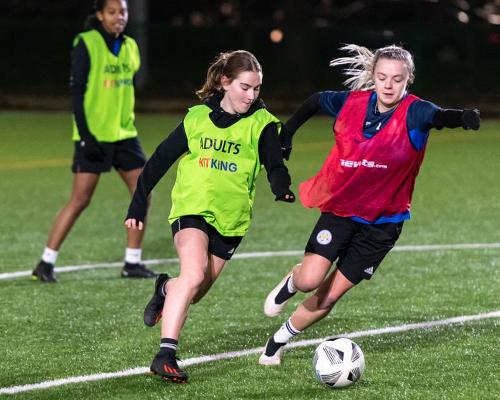07 Dec 2023
Teenage girls are getting more active – the highlight of the new Active Lives survey from Sport England
BY Kath Hudson

Physical activity levels among children and young people have improved compared to five years ago, according to Sport England’s Active Lives Children and Young People Report 22-23, which was published today (7 December 2023).
Overall activity levels are unchanged from last year, but are up 3.8 per cent on the five year figure of 2017, meaning 424,000 more children and young people are active.
The most significant gains have been made among girls aged 13-to-16, which is heartening considering this is an age when drop-off is higher and this has been partly attributed to the success of the Lionesses who are providing such relatable role models and also, access to better football programmes.
Speaking to HCM, Sport England’s chief strategy officer, Nick Pontefract, said women’s football coverage is getting more coverage, which has helped it enter the public consciousness. “The increase in girl’s playing football has been partly stimulated from the bottom up, but it has also been helped by the top-down inspirational effect of the Lionesses.”
During the last three years, activity levels have also increased among those with a disability or long-term health condition: up 4.5 per cent for those with a disability or long term health conditions, compared to 2.3 per cent for those without.
“This is one of the things we continue to be pleased about, especially as it is the opposite to what we see in the adult survey,” says Pontefract. “It shows the payoff for 10 or 15 years of really hard work around inclusion of those with disabilities within sport, particularly in and around schools and clubs.”
While 2.2 million children and young people (30.2 per cent) still do less than 30 minutes of physical activity a day, the number of relativcely inactive young people is falling and this is a 2.7 per cent reduction of 2017, representing an increase of 85,000 children and young people becoming more active.
Active travel, walking, going to the gym and fitness (such as yoga) are all up over the longer term, with a million more children and young people travelling by active means, as well as 592,000 more going for a walk regularly and 908,000 more going to the gym than five years ago, while also using free online resources.
While team sports generally have seen a flat trend, participation in both football and basketball have seen an uptick, with 325,000 more children and young people playing football and an extra 297,000 playing basketball. Pontefract says these are the sports that have worked hard to be seen as relevant and it’s a healthy challenge for other activities to “work as hard as they can to be as relevant as possible.”
Almost half (47 per cent) of children and young people – 3.5 million – are now meeting the Chief Medical Officer's guidelines of an average of more than 60 minutes a day of sport or physical activity. A further 1.7 million (22.8 per cent) of children and young people are fairly active, for an average of 30-59 minutes a day.
However, the report shows affluence and activity levels are closely linked. Those from lower income families are less likely to be physically active (44 per cent). Also Black (40 per cent) and Asian (40 per cent) children continue to be less likely to be active than the average across all ethnicities and social groups.
Sport England has a multi-year plan to tackle the inequalities with its place-based investment programme
which is targeting the 10 per cent most deprived parts of the country. “Every programme we run will be deliberately designed to over-index people from a background that makes them less likely to participate. We think the only way to close the gaps is by disproportionately investing," said Sport England CEO Tim Hollingsworth.
“We'll be building on the learnings from our local delivery pilots we've run over the last few years. We’re also redesigning our open application funds and putting lots more money behind those to make it easier for people who do come to us and say they can make a contribution.”
The Youth Sports Trust lamented the findings of Active Lives Children and Young People Report 22-23, saying inactivity levels are still too high. Chief executive, Ali Oliver, says inactivity has also been shown to impact education and there needs to be more awareness, as 43 per cent of parents are unaware how active their children should be.
“A campaign to highlight why 60 active minutes a day is so important is vital to drive the societal shift we need to see,” she says. “But alongside this, I believe raising the importance of physical development in the early years, supporting all schools to be active learning environments and re-imagining physical education so its sole purpose is healthy learners and active citizens would represent an informed and powerful response to this latest set of Active Lives Data.”
Close Window